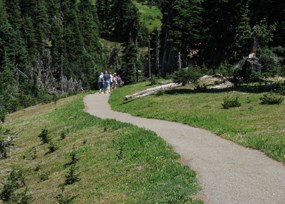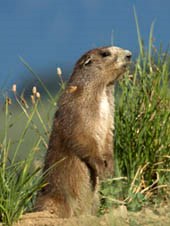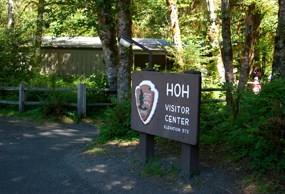
OLYMPIC NATIONAL PARK PHOTO
Fee-Free Days Come to Olympic Aug. 14-15 
PHOTO COURTESY KEN AND MARY CAMPBELL Olympic NP and WNPF Kick Off Marmot Monitoring Project Teams of volunteer “citizen scientists” began training last month as part of a volunteer project to monitor populations of Olympic marmots (Marmota olympus) in Olympic National Park. Thanks to $26,300 in funding from Washington’s National Parks Fund, volunteers will have an opportunity to study population size and distribution of the Olympic marmot throughout the park. The funds were used to purchase GPS units for the volunteer marmot monitors to use while conducting their studies in the field. More than 100 people, hailing from the Olympic Peninsula, Seattle/Tacoma area and as far away as Los Angeles, have signed on to become marmot monitors. Volunteer training began July 20 and will continue over the next several weeks. “The marmot is an iconic species at Olympic,” said Dr. Sue Griffin, who heads up the monitoring program for the park. “More than 90 percent of the species lives within park boundaries, so we have a special responsibility to study and safeguard the animal.” Existing only on (endemic to) the Olympic Peninsula, the Olympic marmot is one of the rarest species of North American marmots. Due to its geographic isolation, the species has evolved in isolation for thousands of years and differs in coloring, vocalization and genetics from the closely-related hoary and Vancouver Island marmots. 
PHOTO BY HENRY MEYER ARRA Funds Help to Rehab Park Facilities Facilities throughout Olympic National Park are undergoing a range of improvements this summer, through funds made available by the American Recovery and Reinvestment Act of 2009 (ARRA), which provided $3 billion to the Department of the Interior. Of that amount, $750 million goes to the National Park Service. In addition to the Boulder Creek rehabilitation project scheduled to get underway August 16, ARRA funds will also allow the park to upgrade sewer treatment facilities, replace roofing on several buildings, and improve electrical connectivity at Hurricane Ridge. Roofing Projects: The Cultural Resources/Fee Building will receive new roofing, as well as peel-and-stick solar panels to generate energy savings. Ten other buildings throughout the park will undergo roofing replacement. Redi-Construction of Port Angeles, Wash. is the contractor for the $238,500 multi-facility project. Electrical: Approximately 12 miles of electrical conduit will be installed along Hurricane Ridge Road, from the Heart O' the Hills entrance station to the Hurricane Ridge Visitors' Center. The contractor for this $562,000 project is CTS Northwest, Inc. of Lynnwood, Wash. Sewage: As part of an $810,529 project, Rognlin's Inc. of Aberdeen, Wash. will construct various elements to double capacity of the sanitary sewer treatment system in the Hoh Rain Forest, which will serve the needs of the campground, picnic area, visitors' center and employee housing. |
Last updated: February 28, 2015
